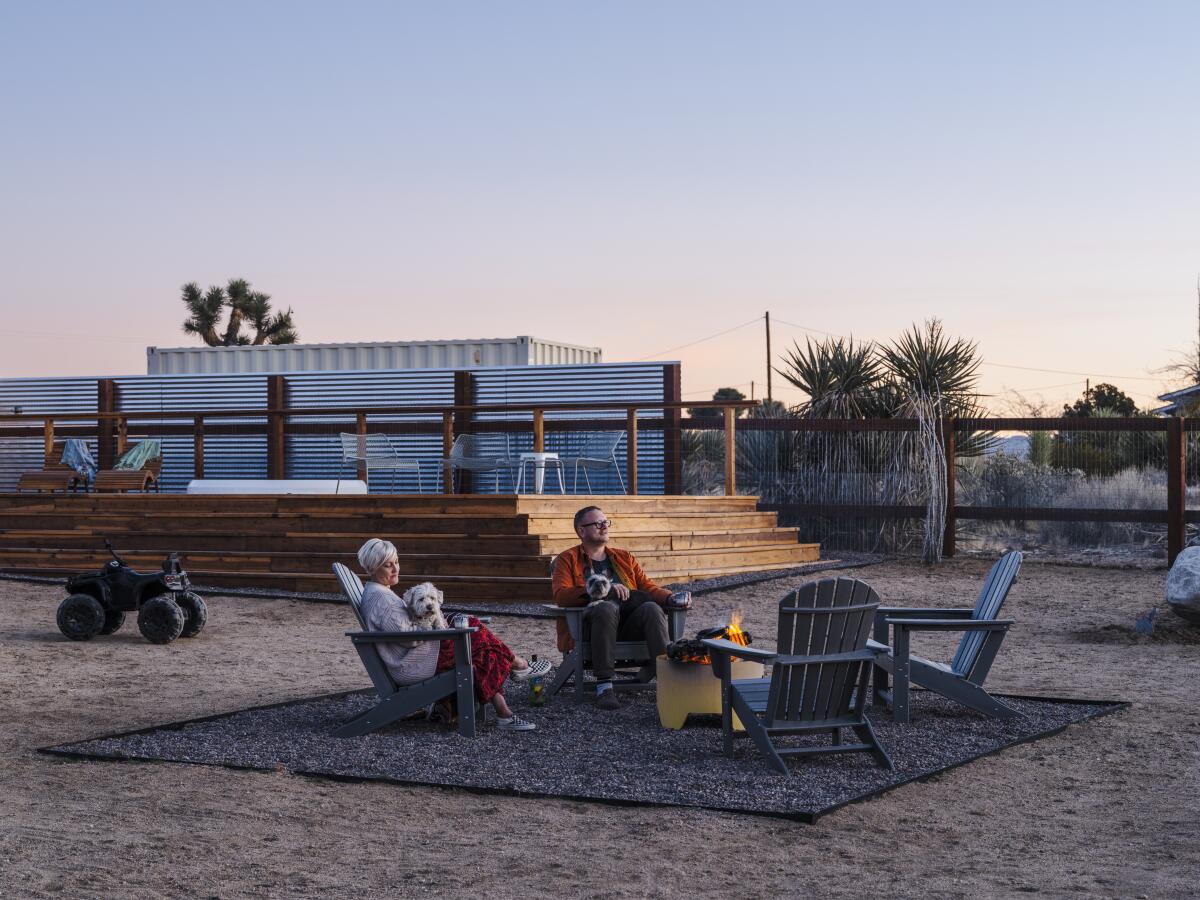Parents are ditching screen time limits for kids against expert advice

- Share via
Good morning. It’s Wednesday, June 26. This is Jenny Gold. I cover early childhood education for The Times. Here’s what you need to know to start your day.
- Too much screen time harms children, experts agree. So why do parents ignore them?
- Newsom attacks ‘delusional California bashers’ in unorthodox speech.
- A giant meatball is the gateway dish to L.A.’s best new Persian restaurant in years.
- And here’s today’s e-newspaper
You're reading the Essential California newsletter
Our reporters guide you through our biggest news, features and recommendations every morning
You may occasionally receive promotional content from the Los Angeles Times.
Parents basically ignore screen time limits for young kids
My husband and I have tried to follow the American Academy of Pediatrics’ recommendations on screen time for our two young children, much to their chagrin. Avoid screens as much as possible for the first two years. Limit screen time to one hour a day of high-quality content from ages 2 to 5.
But then I recently went on a work trip to New York, I came home and soon heard my toddler had a new favorite word: CoComelon. My husband had turned on the TV to distract the kids to cook dinner and do other chores. Our 22-month-old son ratted him out, and CoComelon’s tinkling nursery rhymes have been stuck in my head ever since.
Turns out, my family is far from alone with screen time challenges.
Should parents limit screen time for kids?
A national Common Sense Media survey from 2020 found that few families were coming anywhere close to following the screen time limits recommended by pediatricians — and that was before device use exploded when schools and child-care centers closed during the COVID-19 pandemic. Researchers interviewed 1,500 parents of children who were infants to age 8 and found:
- Children under 2 were watching an average of 49 minutes of digital media a day;
- Children ages 2 to 4 watch an average of 2.5 hours a day;
- Children 5 to 8 watch slightly more than three hours a day.
But despite the dire predictions of experts about the risks of excessive screen time for young children — obesity, behavioral problems, sleep issues, speech and developmental delays — parents don’t seem particularly concerned.
The majority of parents surveyed said that they weren’t worried about the amount of time their kids spend with screens, the effect screen media could have on their child or the quality of the content available to them. In fact, they thought screen time was a net positive — helping their children learn to read, boosting creativity and even improving their social skills.
Why is saying no to screens so hard?
It doesn’t help that screens are everywhere. Nearly half of kids ages 2 to 4 and two-thirds of kids ages 5 to 8 have their own mobile device, according to Common Sense Media.
“I really think it’s more complicated than it was for prior generations,” said Dr. Whitney Casares, a Portland pediatrician and author of the book “Doing It All.” Although TVs have been been popular since the 1950s, they were limited to the home. Cars, restaurants, parks and most other spaces were screen-free zones.
“The access was really different. Sure, kids sat in front of the TV. But parents could turn it off, there weren’t as many options, and it wasn’t on-demand,” Casares said.
Adding to the issue, working parents need to have some type of distraction for their kids, and “screens tend to be the easiest option, the lowest hanging fruit,” she said.
Does screen time affect children’s brain development?
The biggest problem with screen time is what young children aren’t doing while they’re watching — exploring the world and having back-and-forth interactions with caregivers. That’s how babies and toddlers learn, and when they are watching digital media, they lose that time to grow and learn.
This is particularly true for babies and toddlers, because there isn’t a lot of evidence showing they can learn much of anything through screens.
There’s also some limited studies suggesting that children who watched more than the recommended one hour a day had lower development in the parts of the brain dedicated language and early literacy skills.
Will screen time ruin a child?
For preschoolers, there’s evidence that educational shows such as “Sesame Street” can actually help improve literacy and social development, though only in limited amounts.
So to make the most of a child’s screen time, try to limit what they watch to high-quality, educational programming with as few commercials as possible. And whenever possible, watch with them, talk about what you are viewing and ask questions.
When it comes to online videos, it can be much harder to control what your child is watching, and inappropriate content abounds.
A Common Sense Media report on YouTube use found that just 1 in 4 videos viewed by infants to 8-year-olds were educational, and the rest were entertainment. More than a quarter were intended for older audiences, such as gaming videos or compilations of violent content. And 1 in 5 videos showed inappropriate commercials such as ads for lingerie and whiskey.
In general, Jill Murphy, Common Sense Media’s chief content officer, said it’s safer to stick with branded content from a production company that’s intended for young children, which often have child development staff or advisors.
Today’s top stories

Violence at L.A. synagogue
- LAPD, feds look for synagogue protesters as city mulls over mask restrictions, added security.
- Protest violence outside L.A. synagogue spurs widespread condemnation. Bass vows quick action.
Oakland mayor’s FBI raid
- Oakland’s mayor is in crisis as a lawyer and a top aide jump ship following a fiery speech after FBI raid.
- ‘I have done nothing wrong.’ Oakland mayor declares herself innocent in a speech.
- FBI raid of Oakland mayor rocks city, fuels questions over family’s political influence.
- Federal agents raid home of Oakland Mayor Sheng Thao.
Gov. Newsom
- Newsom attacks ‘delusional California bashers’ in unorthodox speech.
- Gov. Newsom is moving his family back to Marin County.
- Column: Why Newsom might not be cut out for Washington.
- Newsom’s budget plan saves vital programs for immigrants, but kids and hungry seniors may suffer.
Climate and environment
- Many Santa Paula residents can’t use their drinking water after a break-in at a city reservoir.
- 1,000 rapid-fire lightning strikes spark California wildfires, with more coming.
- As California’s climate grows ever more hostile, a Joshua tree rescue plan takes shape.
- Cost of bringing clean drinking water to California communities is estimated at $11.5 billion.
- Libraries can still offer free passes to California parks, thanks to budget deal.
The NBA Draft
- Lakers could make major deal to move up in NBA draft, but would it be worth it?
- As Clippers prepare for draft, Paul George’s future hangs in balance.
- Rob Dillingham: From Ye’s Donda Academy debacle to a probable NBA lottery pick.
More big stories
- Whoever wins the Biden-Trump debate, CNN hopes to claim victory.
- She fought remodel evictions for years. Now she’s the one being evicted.
- After protests, UC Berkeley pledges to expand antisemitism education to all new students.
- Ex-’pharma bro’ Martin Shkreli claims he launched a crypto coin with Barron Trump. Where’s the evidence?
- An outsider as next LAPD chief? Candidates face a culture that has ‘spit out’ past leaders.
- L.A.’s newest dinosaur has its forever name.
- Dealer’s conviction for deadly fentanyl dose highlights L.A.’s online drug sales problem.
- As air taxi services make progress in U.S., no timeline is set for liftoff over L.A. traffic.
- Paramount leaders address ‘simply unacceptable’ profit declines after sale talks collapse.
- State recalls vape many months after it was told of contamination.
- Roscoe’s House of Chicken ’n Waffles closes Pasadena location after three decades.
- L.A. County plans to put $5 million toward wiping out medical debt.
Get unlimited access to the Los Angeles Times. Subscribe here.
Commentary and opinions
- Robin Abcarian: After years of running, I quit and took up Pilates. Here’s how that turned out.
- Sammy Roth: Good news for 100% clean energy. Geothermal has finally arrived.
- Mark Z. Barabak: In Biden-Trump debate, what they do — not what they say — could determine the winner.
Today’s great reads
He crossed the Atlantic solo in a boat he built himself. The idea sounded crazy. But a California man decided to test himself. Could he cross the Atlantic in a sailboat no bigger than a pickup truck?
Other great reads
- Jenni Rivera’s family battles over singer’s estate. ‘Money, power, greed’ tear them apart.
- ‘The Bachelor’ producers admit failures on race and ‘inexcusable’ string of white leads.
- ‘Don’t cut down that scene’: ‘I Am: Celine Dion’ director on documenting the singer’s agony.
- Sabrina, Charli and Chappell are suddenly stars. Why now?
How can we make this newsletter more useful? Send comments to [email protected].
For your downtime
Going out
- 🇮🇩 Rendang is Indonesia’s culinary masterpiece. 11 of the best places to get it in L.A.
- 🍴A giant meatball is the gateway dish to L.A.’s best new Persian restaurant in years.
Staying in
- 📖 Former UFC and WWE star Ronda Rousey finds ‘path that I was meant for’ as graphic novelist.
- 🤸 More than the Simone Biles show: What to watch for at U.S. Olympic gymnastics trials.
- 🧑🍳 Here’s a recipe for melon and tomato gazpacho.
- ✏️ Get our free daily crossword puzzle, sudoku, word search and arcade games.
And finally ... a great photo
Show us your favorite place in California! We’re running low on submissions. Send us photos that scream California and we may feature them in an edition of Essential California.

Today’s great photo is from Times contributor Lance Gerber from the property of Los Angeles artists and gallerists Adam Miller and Devon Oder who turned a tiny one-bedroom cabin in Yucca Valley into an art-filled oasis for their family and community.
Have a great day, from the Essential California team
Kevinisha Walker, multiplatform editor and Saturday reporter
Christian Orozco, assistant editor
Stephanie Chavez, deputy metro editor
Karim Doumar, head of newsletters
Check our top stories, topics and the latest articles on latimes.com.
Sign up for Essential California
The most important California stories and recommendations in your inbox every morning.
You may occasionally receive promotional content from the Los Angeles Times.






